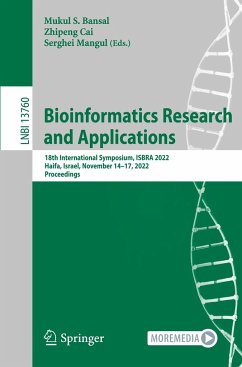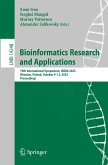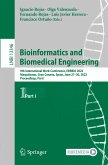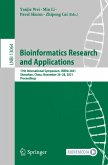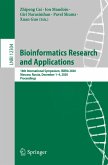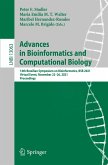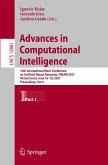Bioinformatics Research and Applications
18th International Symposium, ISBRA 2022, Haifa, Israel, November 14-17, 2022, Proceedings
Herausgegeben:Bansal, Mukul S.; Cai, Zhipeng; Mangul, Serghei
Bioinformatics Research and Applications
18th International Symposium, ISBRA 2022, Haifa, Israel, November 14-17, 2022, Proceedings
Herausgegeben:Bansal, Mukul S.; Cai, Zhipeng; Mangul, Serghei
- Broschiertes Buch
- Merkliste
- Auf die Merkliste
- Bewerten Bewerten
- Teilen
- Produkt teilen
- Produkterinnerung
- Produkterinnerung
This book constitutes the proceedings of the 18th International Symposium on Bioinformatics Research and Applications, ISBRA 2022, held in Haifa, Israel, in November 14-17, 2022. The 30 full papers and 4 short papers presented in this book were carefully reviewed and selected from 72 submissions. They were organized in topical sections named: AI and disease; computational proteomics; biomedical imaging; drug screening and drug-drug interaction prediction; Biomedical data; sequencing data analysis.
Andere Kunden interessierten sich auch für
![Bioinformatics Research and Applications Bioinformatics Research and Applications]() Bioinformatics Research and Applications64,99 €
Bioinformatics Research and Applications64,99 €![Bioinformatics and Biomedical Engineering Bioinformatics and Biomedical Engineering]() Bioinformatics and Biomedical Engineering93,99 €
Bioinformatics and Biomedical Engineering93,99 €![Bioinformatics Research and Applications Bioinformatics Research and Applications]() Bioinformatics Research and Applications77,99 €
Bioinformatics Research and Applications77,99 €![Bioinformatics Research and Applications Bioinformatics Research and Applications]() Bioinformatics Research and Applications39,99 €
Bioinformatics Research and Applications39,99 €![Advances in Bioinformatics and Computational Biology Advances in Bioinformatics and Computational Biology]() Advances in Bioinformatics and Computational Biology43,99 €
Advances in Bioinformatics and Computational Biology43,99 €![Bio-Inspired Information and Communications Technologies Bio-Inspired Information and Communications Technologies]() Bio-Inspired Information and Communications Technologies58,99 €
Bio-Inspired Information and Communications Technologies58,99 €![Advances in Computational Intelligence Advances in Computational Intelligence]() Advances in Computational Intelligence77,99 €
Advances in Computational Intelligence77,99 €-
-
-
This book constitutes the proceedings of the 18th International Symposium on Bioinformatics Research and Applications, ISBRA 2022, held in Haifa, Israel, in November 14-17, 2022.
The 30 full papers and 4 short papers presented in this book were carefully reviewed and selected from 72 submissions. They were organized in topical sections named: AI and disease; computational proteomics; biomedical imaging; drug screening and drug-drug interaction prediction; Biomedical data; sequencing data analysis.
The 30 full papers and 4 short papers presented in this book were carefully reviewed and selected from 72 submissions. They were organized in topical sections named: AI and disease; computational proteomics; biomedical imaging; drug screening and drug-drug interaction prediction; Biomedical data; sequencing data analysis.
Produktdetails
- Produktdetails
- Lecture Notes in Computer Science 13760
- Verlag: Springer / Springer Nature Switzerland / Springer, Berlin
- Artikelnr. des Verlages: 978-3-031-23197-1
- 1st ed. 2022
- Seitenzahl: 408
- Erscheinungstermin: 2. Januar 2023
- Englisch
- Abmessung: 235mm x 155mm x 23mm
- Gewicht: 616g
- ISBN-13: 9783031231971
- ISBN-10: 303123197X
- Artikelnr.: 66381700
- Herstellerkennzeichnung Die Herstellerinformationen sind derzeit nicht verfügbar.
- Lecture Notes in Computer Science 13760
- Verlag: Springer / Springer Nature Switzerland / Springer, Berlin
- Artikelnr. des Verlages: 978-3-031-23197-1
- 1st ed. 2022
- Seitenzahl: 408
- Erscheinungstermin: 2. Januar 2023
- Englisch
- Abmessung: 235mm x 155mm x 23mm
- Gewicht: 616g
- ISBN-13: 9783031231971
- ISBN-10: 303123197X
- Artikelnr.: 66381700
- Herstellerkennzeichnung Die Herstellerinformationen sind derzeit nicht verfügbar.
MLMVFE: A Machine Learning Approach Based on Muli-View Features Extraction for Drug-Disease Associations Prediction.- STgcor: A Distribution-based Correlation MeasurementMethod for Spatial Transcriptome Data.- Automatic ICD Coding based on Multi-granularity Feature Fusion.- Effectively Training MRI Reconstruction Network via Sequentially Using Undersampled k-Space Data with Very Low Frequency Gaps.- Fusing Label Relations for Chinese EMR Named Entity Recognition with Machine Reading Comprehension.- Private Epigenetic PaceMaker Detector using Homomorphic Encryption - Extended Abstract.- NIDN: Medical Code Assignment via Note-Code Interaction Denoising Network.- Research on the prediction method of disease classification based on imaging features.- M-US-EMRs: A Multi-Modal Data Fusion Method of Ultrasonic Images and Electronic Medical Records Used for Screening of Coronary Heart Disease.- Transposition Distance Considering Intergenic Regions for Unbalanced Genomes.- An SMT-based Framework for Reasoning about Discrete Biological Models.- ARGLRR: An Adjusted Random Walk Graph Regularization Sparse Low-rank Representation Method for Single-cell RNA-sequencing Data Clustering.- An Efficient and User-friendly Software for PCR Primer Design for Detection of Highly Variable Bacteria.- A Network-Based Voting Method for Identification and Prioritization of Personalized Cancer Driver Genes.- TDCOSR: A multimodality fusion framework for association analysis between genes and ROIs of Alzheimer's disease.- Policy-based Hypertension Monitoring using Formal Runtime Verification Monitors.- Deep learning-enhanced MHC-II presentation prediction and peptidome deconvolution.- MMLN: Leveraging Domain Knowledge for Multimodal Diagnosis.- Optimal sequence alignment to ED-strings.- Heterogeneous PPInetwork representation learning for protein complex identification.- A Clonal Evolution Simulator for Planning Somatic Evolution Studies.- Prediction of Drug-disease Relationship on Heterogeneous Networks Based on Graph Convolution.- t-SNE Highlights Phylogenetic and Temporal Patterns of SARS-CoV-2 Spike and Nucleocapsid Protein Evolution.- MPCDDI: A Secure Multiparty Computation-based Deep Learning Framework for Drug-drug Interaction Predictions.- A Multimodal Data Fusion-based Deep Learning Approach for Drug-Drug Interaction Prediction.- GNN-Dom: an unsupervised method for protein domain partition via protein contact map.- A Locality-Constrained Linear Coding-Based Ensemble Learning Framework for Predicting Potentially Disease-Associated MiRNAs.- Gaussian-enhanced Representation Model for Extracting Protein-Protein Interactions Affected by Mutations.- Distance Profiles of Optimal RNA Foldings.- 2D Photogrammetry Image of Adolescent Idiopathic Scoliosis Screening Using Deep Learning.- EMRShareChain: A Privacy-Preserving EMR Sharing System Model Based on the Consortium Blockchain.- Simulating Spiking Neural Networks based on SW26010pro.- Entropy Based Clustering of Viral Sequences.- A Tensor Robust Model Based on Enhanced Tensor Nuclear Norm and Low-Rank Constraint for Multi-view Cancer Genomics Data.
MLMVFE: A Machine Learning Approach Based on Muli-View Features Extraction for Drug-Disease Associations Prediction.- STgcor: A Distribution-based Correlation MeasurementMethod for Spatial Transcriptome Data.- Automatic ICD Coding based on Multi-granularity Feature Fusion.- Effectively Training MRI Reconstruction Network via Sequentially Using Undersampled k-Space Data with Very Low Frequency Gaps.- Fusing Label Relations for Chinese EMR Named Entity Recognition with Machine Reading Comprehension.- Private Epigenetic PaceMaker Detector using Homomorphic Encryption - Extended Abstract.- NIDN: Medical Code Assignment via Note-Code Interaction Denoising Network.- Research on the prediction method of disease classification based on imaging features.- M-US-EMRs: A Multi-Modal Data Fusion Method of Ultrasonic Images and Electronic Medical Records Used for Screening of Coronary Heart Disease.- Transposition Distance Considering Intergenic Regions for Unbalanced Genomes.- An SMT-based Framework for Reasoning about Discrete Biological Models.- ARGLRR: An Adjusted Random Walk Graph Regularization Sparse Low-rank Representation Method for Single-cell RNA-sequencing Data Clustering.- An Efficient and User-friendly Software for PCR Primer Design for Detection of Highly Variable Bacteria.- A Network-Based Voting Method for Identification and Prioritization of Personalized Cancer Driver Genes.- TDCOSR: A multimodality fusion framework for association analysis between genes and ROIs of Alzheimer's disease.- Policy-based Hypertension Monitoring using Formal Runtime Verification Monitors.- Deep learning-enhanced MHC-II presentation prediction and peptidome deconvolution.- MMLN: Leveraging Domain Knowledge for Multimodal Diagnosis.- Optimal sequence alignment to ED-strings.- Heterogeneous PPInetwork representation learning for protein complex identification.- A Clonal Evolution Simulator for Planning Somatic Evolution Studies.- Prediction of Drug-disease Relationship on Heterogeneous Networks Based on Graph Convolution.- t-SNE Highlights Phylogenetic and Temporal Patterns of SARS-CoV-2 Spike and Nucleocapsid Protein Evolution.- MPCDDI: A Secure Multiparty Computation-based Deep Learning Framework for Drug-drug Interaction Predictions.- A Multimodal Data Fusion-based Deep Learning Approach for Drug-Drug Interaction Prediction.- GNN-Dom: an unsupervised method for protein domain partition via protein contact map.- A Locality-Constrained Linear Coding-Based Ensemble Learning Framework for Predicting Potentially Disease-Associated MiRNAs.- Gaussian-enhanced Representation Model for Extracting Protein-Protein Interactions Affected by Mutations.- Distance Profiles of Optimal RNA Foldings.- 2D Photogrammetry Image of Adolescent Idiopathic Scoliosis Screening Using Deep Learning.- EMRShareChain: A Privacy-Preserving EMR Sharing System Model Based on the Consortium Blockchain.- Simulating Spiking Neural Networks based on SW26010pro.- Entropy Based Clustering of Viral Sequences.- A Tensor Robust Model Based on Enhanced Tensor Nuclear Norm and Low-Rank Constraint for Multi-view Cancer Genomics Data.

